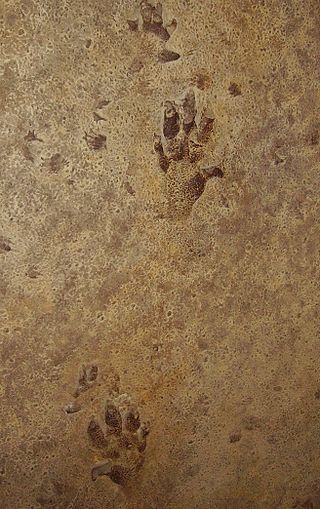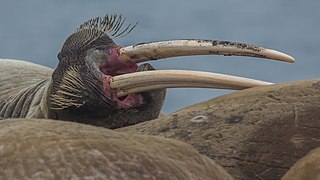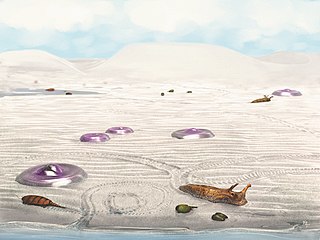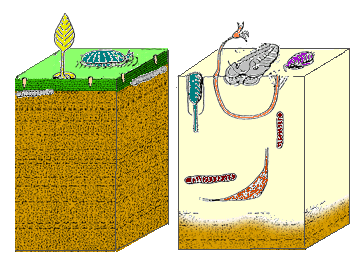
The Cambrian is the first geological period of the Paleozoic Era, and of the Phanerozoic Eon. The Cambrian lasted 53.4 million years from the end of the preceding Ediacaran period 538.8 million years ago (mya) to the beginning of the Ordovician period 485.4 mya. Its subdivisions, and its base, are somewhat in flux.
The cloudinids, an early metazoan family containing the genera Acuticocloudina, Cloudina and Conotubus, lived in the late Ediacaran period about 550 million years ago. and became extinct at the base of the Cambrian. They formed millimetre-scale conical fossils consisting of calcareous cones nested within one another; the appearance of the organism itself remains unknown. The name Cloudina honors the 20th-century geologist and paleontologist Preston Cloud.

Cyclomedusa is a circular fossil of the Ediacaran biota; it has a circular bump in the middle and as many as five circular growth ridges around it. Many specimens are small, but specimens in excess of 20 cm are known. The concentric disks are not necessarily circular, especially when adjacent individuals interfere with each other's growth. Many radial segment lines — somewhat pineapple-like — extend across the outer disks. A few specimens show what might be a stem extending from the center in some direction or other.

A trace fossil, also known as an ichnofossil, is a fossil record of biological activity by lifeforms but not the preserved remains of the organism itself. Trace fossils contrast with body fossils, which are the fossilized remains of parts of organisms' bodies, usually altered by later chemical activity or mineralization. The study of such trace fossils is ichnology and is the work of ichnologists.

Kimberella is an extinct genus of bilaterian known only from rocks of the Ediacaran period. The slug-like organism fed by scratching the microbial surface on which it dwelt in a manner similar to the gastropods, although its affinity with this group is contentious.

Bioturbation is defined as the reworking of soils and sediments by animals or plants. It includes burrowing, ingestion, and defecation of sediment grains. Bioturbating activities have a profound effect on the environment and are thought to be a primary driver of biodiversity. The formal study of bioturbation began in the 1800s by Charles Darwin experimenting in his garden. The disruption of aquatic sediments and terrestrial soils through bioturbating activities provides significant ecosystem services. These include the alteration of nutrients in aquatic sediment and overlying water, shelter to other species in the form of burrows in terrestrial and water ecosystems, and soil production on land.

Vendobionts or Vendozoans (Vendobionta) are a proposed very high-level, extinct clade of benthic organisms that made up of the majority of the organisms that were part of the Ediacaran biota. It is a hypothetical group and at the same time, it would be the oldest of the animals that populated the Earth about 580 million years ago, in the Ediacaran period. They became extinct shortly after the so-called Cambrian explosion, with the introduction of fauna formed by more recognizable groups and more related to modern animals. It is very likely that the whole Ediacaran biota is not a monophyletic clade and not every genus placed in its subtaxa is an animal.

Zoophycos is a somewhat cosmopolitan ichnogenus thought to be produced by moving and feeding polychaete worms.

Climactichnites is an enigmatic, Cambrian fossil formed on or within sandy tidal flats around 510 million years ago. It has been interpreted in many different ways in the past, but is now thought to be a trace fossil of a slug-like organism that moved by crawling to on-shore surfaces, or near-shore, or burrowing into the sediment.

The Ediacaranbiota is a taxonomic period classification that consists of all life forms that were present on Earth during the Ediacaran Period. These were enigmatic tubular and frond-shaped, mostly sessile, organisms. Trace fossils of these organisms have been found worldwide, and represent the earliest known complex multicellular organisms. The term "Ediacara biota" has received criticism from some scientists due to its alleged inconsistency, arbitrary exclusion of certain fossils, and inability to be precisely defined.
The Burgess Shale of British Columbia is famous for its exceptional preservation of mid-Cambrian organisms. Around 69 other sites have been discovered of a similar age, with soft tissues preserved in a similar, though not identical, fashion. Additional sites with a similar form of preservation are known from the Ediacaran and Ordovician periods.
Oldhamia is an ichnogenus describing burrows produced by worm-like organisms mining underneath microbial mats. It was common from the Early Cambrian deep-water deposits.
The end-Ediacaran extinction is a mass extinction believed to have occurred near the end of the Ediacaran period, the final period of the Proterozoic eon. Evidence suggesting that such a mass extinction occurred includes a massive reduction in diversity of acritarchs, the sudden disappearance of the Ediacara biota and calcifying organisms, and the time gap before Cambrian organisms "replaced" them. Some lines of evidence suggests that there may have been two distinct pulses of the extinction event, one occurring 550 million years ago and the other 539 million years ago.

A microbial mat is a multi-layered sheet of microorganisms, mainly bacteria and archaea, or bacteria alone. Microbial mats grow at interfaces between different types of material, mostly on submerged or moist surfaces, but a few survive in deserts. A few are found as endosymbionts of animals.
The Cambrian explosion is an interval of time approximately 538.8 million years ago in the Cambrian period of the early Paleozoic when there was a sudden radiation of complex life, and practically all major animal phyla started appearing in the fossil record. It lasted for about 13 to 25 million years and resulted in the divergence of most modern metazoan phyla. The event was accompanied by major diversification in other groups of organisms as well.
Ediacaran type preservation relates to the dominant preservational mode in the Ediacaran period, where Ediacaran organisms were preserved as casts on the surface of microbial mats.

Blackberry Hill is a Konservat-Lagerstätte of Cambrian age located within the Elk Mound Group in Marathon County, Wisconsin. It is found in a series of quarries and outcrops that are notable for their large concentration of exceptionally preserved trace fossils in Cambrian tidal flats. One quarry in particular also has the distinction of preserving some of the first land animals. These are preserved as three-dimensional casts, which is unusual for Cambrian animals that are only lightly biomineralized. Additionally, Blackberry Hill is the first occurrence recognized to include Cambrian mass strandings of scyphozoans (jellyfish).

Kimberichnus is an ichnofossil associated with the early bilaterian Kimberella. It is known mostly from shallow marine Ediacaran sediments, often occurring alongside its producer. Kimberichnus often occurs in Russia and South Australia, where it is most abundant in the shape of multiple arcuate sets of ridges with fan-shaped arrangements.

Matgrounds are strong surface layers of seabed-hardening bacterial fauna preserved in the Proterozoic and lower Cambrian. Wrinkled matgrounds are informally named "elephant skin" because of its wrinkled surface in the fossil record. Matgrounds supported themselves until early burrowing worms were ubiquitous enough to unharden them. Burrowing animals broke down the hardy mats to further penetrate the underlying sediment for protection and feeding. Once matgrounds disappeared, exceptional preservation of lagerstätten such as the Burgess Shale or Ediacara Hills also did so too. Trace fossils such as Treptichnus are evidence for soft-bodied burrowers more anatomically complex than the Ediacaran biota that also caused the matgrounds disappearance.

Bergaueria is an Ediacaran–Silurian trace fossil believed to represent the dwelling trace of Cnidarians. It likely caused mixing and fluid exchange into the sediment (bioirrigation). Similar traces (Cheiichnus) can be made by rotational movement of arthropods.

















